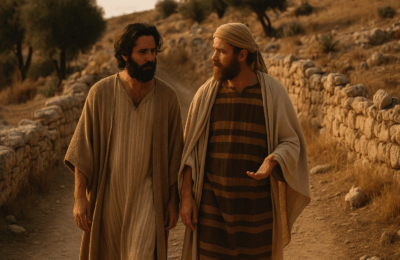Home | Bible Resources | Historical Books
1 Samuel: A Kingdom Begins – From Judges to David
Introduction
The book of 1 Samuel marks a pivotal turning point in redemptive history — the transition from tribal anarchy to centralized monarchy in Israel. Set in the chaos following the period of the judges, this narrative introduces us to three towering figures: Samuel the prophet, Saul the people’s king, and David the man after God’s heart. It is a story of divine calling, national identity, prophetic leadership, and covenantal testing. But beneath the politics and battlefield clashes lies a deeper spiritual crisis — Israel’s desire to be “like the nations” (1 Samuel 8:5). God responds by orchestrating His sovereign purposes through flawed people, preserving the messianic line and preparing the way for the true King to come. Through prophetic voices, broken kings, and divine providence, 1 Samuel lays the groundwork for the Davidic covenant — a cornerstone in the storyline of redemption.
1. Title, Author, and Date
Meaning and Authorship: The Hebrew title, Shemuel (שְׁמוּאֵל), means “Name of God” or “God has heard.” The Greek Septuagint and Latin Vulgate divided the unified Samuel scroll into two parts: 1 and 2 Samuel. Traditionally, authorship is attributed to the prophet Samuel (cf. 1 Chr 29:29), with later prophetic additions by Nathan and Gad.
Date and Historical Context: Events span roughly 1105–1010 BC, covering the end of the judges (Eli), the birth and ministry of Samuel, the rise and fall of Saul, and the anointing of David. The final compilation may have been completed during the early monarchic period, possibly under David or Solomon.
Redemptive Role: 1 Samuel serves as a bridge between the theocratic rule of the judges and the beginning of the monarchy. It introduces the Davidic line, through which the Messiah would come, and highlights God’s providence, covenantal faithfulness, and sovereign rule.
📊 Book Stats:
Chapters: 31
Verses: 810
Approx. Word Count: 25,000 (Hebrew)
2. Purpose and Themes
Central Purpose
To demonstrate that Israel’s human kingship must submit to God’s authority, and to trace the rise of the Davidic line as the vehicle for God’s redemptive plan.
Major Doctrines and Themes
- Sovereignty of God: Over history, leadership, and human decisions (1 Sam 2:6–10).
- Prophetic Authority: Samuel’s role as transitional judge and prophet.
- Covenant Kingship: Foundations for the Davidic Covenant.
- Rejection of Worldly Imitation: Israel’s demand for a king “like the nations.”
- Divine Election vs. Human Appearance: God sees the heart (1 Sam 16:7).
- Faith and Obedience: The contrast between Saul’s failure and David’s trust.
Literary Features
- Prophetic narrative interwoven with historical realism
- Chiasms in Hannah’s song and David’s rise
- Parallel structure: Saul’s rise and fall ↔ David’s rise and favor
3. Outline
The book follows the rise of prophetic leadership (Samuel), the flawed kingship of Saul, and God’s sovereign selection of David, preparing the way for the messianic kingdom.
I. Samuel: Prophet, Priest, and Judge (Ch. 1–7)
A. Hannah’s Prayer and Samuel’s Birth (1:1–2:11)
B. The Corruption of Eli’s Sons and God’s Judgment (2:12–4:22)
C. The Ark Narrative and Yahweh’s Supremacy (5:1–7:2)
D. National Repentance and Samuel’s Leadership (7:3–17)
II. Saul: Israel’s First King (Ch. 8–15)
A. Israel Demands a King (8:1–22)
B. Saul’s Anointing and Early Victories (9:1–11:15)
C. Samuel’s Farewell and Covenant Renewal (12:1–25)
D. Saul’s Disobedience and Rejection (13:1–15:35)
III. David: God’s Anointed King in Waiting (Ch. 16–31)
A. David’s Anointing and Saul’s Jealousy (16:1–18:30)
B. David’s Flight and Growing Leadership (19:1–22:23)
C. David Spares Saul: Mercy over Vengeance (23:1–26:25)
D. David’s Testing in Ziklag (27:1–30:31)
E. Saul’s Death and Tragic End (31:1–13)
Canonical Flow: 1 Samuel transitions us from Judges to Kings, preparing the way for the Davidic Covenant in 2 Samuel and the ultimate fulfillment in Christ, the Son of David (Luke 1:32–33).
4. Key Themes and Theological Contributions
Meta-Narrative Links
- Creation: God raises up new leaders to order His people.
- Fall: Saul embodies the tragic results of fleshly leadership.
- Redemption: David, a man after God’s heart, prefigures the righteous King to come.
- Restoration: God’s promises endure beyond human failure.
Typology and Foreshadowing
- Samuel → Christ as Prophet, Priest, and Judge
- David → Christ as Anointed King
- Ark narrative → God’s holiness and presence beyond manmade control
Memory Verse: 1 Samuel 16:7b (LSB) — “For God does not see as man sees, since man looks at the outward appearance, but Yahweh looks at the heart.”
⚔️ Major Rebellions or Turning Points
- Israel Rejects Yahweh as King (1 Samuel 8:7): The nation demands a king like the nations, exposing spiritual compromise.
- Saul’s Unauthorized Sacrifice (1 Samuel 13): Saul’s impatience and disregard for divine command initiate his downfall.
- Saul Spares Amalek (1 Samuel 15): His partial obedience results in divine rejection — a critical moment of covenantal failure.
5. Christ in 1 Samuel
- Prophetic Role: Samuel prefigures Christ as the faithful intercessor and prophet.
- Davidic Typology: David’s anointing, persecution, and kingship typify Christ’s rejection and ultimate reign.
- Anointed One (Messiah): The term “Messiah” is introduced (1 Sam 2:10; 2:35), pointing to the coming Christ (cf. Luke 4:18, Acts 2:30).
- Kingdom Pattern: The longing for a righteous king is fulfilled in Jesus, the true Son of David (Matthew 1:1).
Suggested OT–NT Cross-Reference Chart:
| Type in 1 Samuel | Fulfillment in Christ |
|---|---|
| Samuel: Prophet and Judge | Jesus as final Prophet and Judge (Acts 3:22–23) |
| David’s Anointing | Jesus anointed by the Spirit (Luke 3:22) |
| David’s Mercy to Saul | Christ’s mercy to enemies (Rom 5:8) |
| Hannah’s Song | Mary’s Magnificat (Luke 1:46–55) |
6. Historical and Literary Notes
ANE Parallels
- Kingship models echo Canaanite and Mesopotamian traditions, but Israel’s king was to be under Torah (Deut. 17:14–20).
- The Philistines dominate geopolitics, introducing iron weaponry and cultural pressure.
Genre
- Historical narrative with prophetic interpretation
- Early royal chronicles with theological emphasis
Key Characters:
- Samuel — Last judge, first prophet of monarchy, kingmaker
- Saul — First king of Israel, chosen then rejected
- David — Shepherd, warrior, God’s anointed
- Hannah — Faithful mother whose prayer shapes a prophet
- Jonathan — Saul’s son, covenant friend of David
- Eli — High priest whose house is judged
7. Applications for Today
Discipleship Formation
- Trust God’s timing and sovereign hand in leadership and suffering
- Obedience is better than sacrifice — partial obedience is still disobedience
- God raises up faithful servants in faithless generations
Worldview and Ethics
- Reject the desire to be “like the nations” — discern worldly conformity
- Leadership must be accountable to God’s Word, not public pressure
- God values the heart over outward performance
Leadership and Mission
- David’s courage vs. Saul’s cowardice offers a model of Spirit-empowered leadership
- Faithfulness in obscurity often precedes public responsibility
- Prepare leaders who walk in humility, dependence, and courage
8. Shoe Leather Discipleship Tie-In
This book shows us that God is never absent, even when earthly leaders fail. In the middle of cultural confusion and spiritual compromise, He raises up faithful men and women to accomplish His purposes. 1 Samuel calls us to walk humbly, lead courageously, and trust the unseen work of God in seasons of waiting, conflict, and calling. Like David, we are formed in the wilderness before crowned in victory. The heart that follows God—fully, faithfully, and fearlessly—is the heart He uses to shape history.







